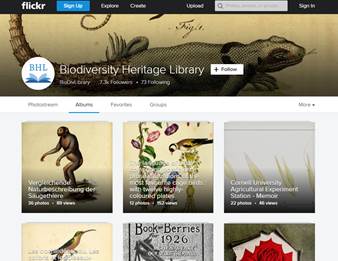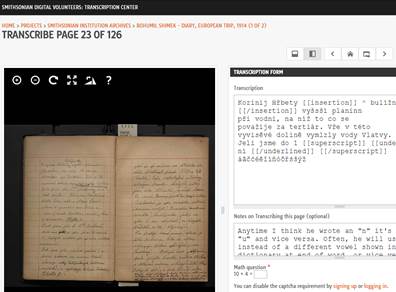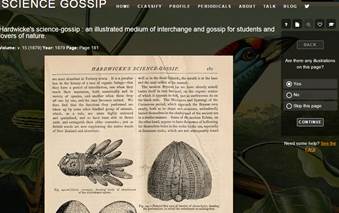As a digital library, BHL offers volunteer opportunities for individuals to contribute their time and expertise from anywhere, any time.
Current opportunities include:
Completed projects:
Current Opportunities
Image Tagging
 BHL books contain thousands of illustrations and we’ve made over 300,000 of those available on Flickr. But we need help to tag these images and make them discoverable by species name, artist name, geographic location, and more! Learn about how you can help by checking out our machine tagging tutorial.
BHL books contain thousands of illustrations and we’ve made over 300,000 of those available on Flickr. But we need help to tag these images and make them discoverable by species name, artist name, geographic location, and more! Learn about how you can help by checking out our machine tagging tutorial.
- Get started: Tagging
Transcribe Field Notes and Archival Materials
 In addition to published biodiversity literature, BHL’s digital corpus includes a growing body of scientists’ field notes and related archival materials. However, the largely handwritten nature of these materials aren’t well-suited to BHL’s OCR (optical character recognition) tools that enable full text search across the collection’s 60 million+ pages.
In addition to published biodiversity literature, BHL’s digital corpus includes a growing body of scientists’ field notes and related archival materials. However, the largely handwritten nature of these materials aren’t well-suited to BHL’s OCR (optical character recognition) tools that enable full text search across the collection’s 60 million+ pages.
Thanks to partnerships with the Smithsonian Transcription Center, DigiVol, and FromThePage, many of these field books and archival materials are being made available for crowdsourcing to produce transcriptions that can be uploaded to BHL in place of the automatically-generated OCR. Help us unlock the valuable data and information in these rich primary resources by visiting one of our partners’ transcription sites.
- Get started Transcribing: Several BHL Partners have transcription projects on various crowdsourcing platforms. Follow the links below to explore the opportunities and get involved:
- Auckland War Memorial Museum Tamaki Paenga Hira on FromThePage
- Ernst Mayr Library of Harvard University on DigiVol
- Harvard Botany Libraries on FromThePage
- Lenhardt Library, Chicago Botanic Garden on FromThePage
- The John Torrey Papers from The New York Botanical Garden on FromThePage
- Smithsonian Institution Archives on the Smithsonian Transcription Center
- Ukrainian Collection items from the National Agricultural Library (NAL) on FromThePage
Completed Projects
Image Classification
 Note: This project is now complete. Nearly ten thousand volunteers produced more than half a million classifications.
Note: This project is now complete. Nearly ten thousand volunteers produced more than half a million classifications.
Through a partnership with Zooniverse, the Science Gossip project was designed to help us unlock the history of citizen science. In the Victorian period, just like today, scientists and members of the public worked together to further scientific discovery. Through this project, volunteers helped classify drawings from Victorian periodicals, such as Science Gossip, Recreative Science and The Intellectual Observer.